THE ECONOMICS OF SOWING DECISIONS AND LIMITED SOIL WATER
| Date: 14 Sep 2010
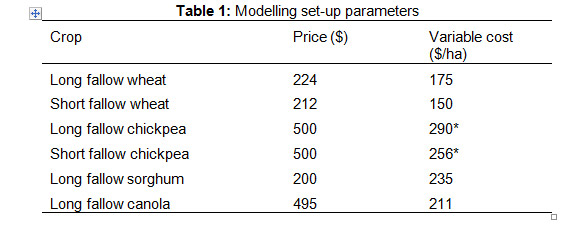
Methods
The APSIM crop simulation model was used to determine the long-term effects on financial returns of different soil water levels (SSW) at planting. Four rotations of length four years were tested. A wheat/wheat/wheat rotation that is widely used in the district was simulated using a range of soil water trigger points. The decision point for the trigger points was assumed to occur at the start of the second wheat crop. At this point the three alternative scenarios were created:
• Skip the second wheat and long fallow to sorghum then long fallow to wheat
• Skip the second wheat and long fallow to sorghum then long fallow to chickpea
• Skip the second wheat and go through an ‘extended’ fallow to another wheat crop two years later then a ‘short’ fallow to wheat
• All the rotations ended with a ‘short’ fallow to wheat in the fourth year
• For each rotation, the simulations ran for four years with the starting date progressing in one year steps for 113 starting dates. The average yields and gross margins were the averages of these 113 four-year runs with the tested soil water trigger set for EACH of those years. Thus, an instance of each possible season type after the decision point with its soil water trigger was included in the analysis.
• The hypothesis was that starting with low soil water could cause the ‘second’ wheat crop to have low yield, using the available water then cause the next crop to also suffer a lowered yield. The alternative was long fallow to sorghum (then either wheat or chickpea) or an ‘extended’ fallow to wheat.
After the decision points, the water was accumulated using ASPIM from the rainfall file. The subsequent crops were planted annually on set dates of:
Wheat – 1 May
Chickpea – 15 June
Sorghum – 1 October Other parameters are listed in Table 1.
Soil water trigger points from 18mm to 180mm in 18mm increments were tested. The soil water triggers referred to the total amount of water in the full 1.5m depth of soil. The total soil water-holding capacity was 180mm.
It needs to be remembered that no effects of weeds, diseases or frosts are taken into account in the modelling process.
The rotations examined were:
Rotation 1 (Wheat and chickpeas on short fallows)
Decision point is in year 1
Year 0 Year 1 Year 2 Year 3 Year 4
| fallow wheat | fallow wheat | fallow wheat | fallow wheat | fallow wheat |
Decision point is in year 1
Rotation 2 (Introducing sorghum into the winter crop rotation)
Decision point is in year 1
Year 0 Year 1 Year 2 Year 4 Year 4
| fallow wheat | fallow fallow | Sorghum fallow | fallow wheat | fallow wheat |
Used to test if there is a financial advantage of introducing long fallow sorghum. Long fallow wheat follows.
Rotation 3. Includes wheat, sorghum and canola
Decision point is in year 1
Year 0 Year 1 Year 2 Year 4 Year 4
| fallow wheat | fallow fallow | Sorghum fallow | fallow chickpea | fallow wheat |
Used to test if there is a financial advantage of introducing long fallow sorghum. Long fallow chickpea follows.
Rotation 4. Includes wheat and an ‘extended’ fallow
Decision point is in year 1
Year 0 Year 1 Year 2 Year 3 Year 4
| fallow wheat | fallow fallow | fallow wheat | fallow wheat | fallow wheat |
An extended (18-month) fallow to wheat was created followed by a ‘short’ fallow to wheat, then a short fallow to wheat.
The other setup parameters (planting times, cultivars, plant density, cost and prices etc) are shown Table 1.
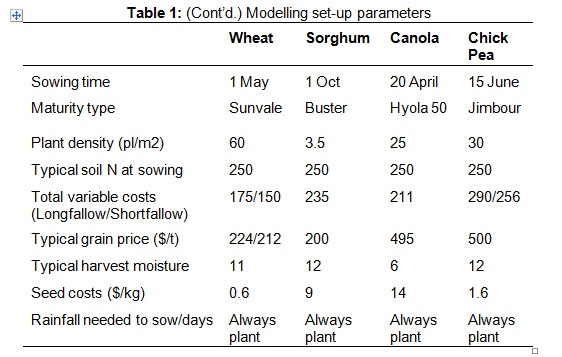
Results
Gross margins using soil water triggers set as the currently available soil water
If the soil water triggers are greater than approximately 50mm, the standard winter-to-winter crop rotation (Rotation 1) gave the highest gross margin (Figure 1). This was a result of the shorter fallows and the higher cropping frequency. With soil water quantities of less than 50mm at the decision, the optimum rotation is the 18 month ‘extended’ fallow to wheat (Rotation 4) (Figure 1). Rotations 2 and 3 included a long fallow to sorghum were less profitable than the winter-to-winter rotation (R1) and the extended fallow (R4). This was caused by the lower cropping frequency and the relatively lower yields for sorghum and chickpea
Lower returns from Rotation 2 are evident at all soil water trigger values. The combination of the lower cropping frequency, lower yields from chickpea than canola (Figure 3) and the higher costs from chickpea compared to canola, combined to reduce gross margins.

Figure 1: Gross margins of the four rotations as a function of soil water at the decision point. Each point is the average annual gross margin in the four years following the decision and incorporates 113 four-year periods commencing 1890. Average yields
Doing your own simulations
The above simulations were conducted with the ‘full’ APSIM model to create crop rotations. An easy to use program (Whopper Cropper) is available that enables comparison of the effects of the following on SINGLE crops:
• soil water-holding capacity
• soil water at planting
• crop type
• time of planting
• N fertiliser rate
• crop maturity type
• planting density
• SOI phase effect on likely yields
• Gross margins of the above
The effect of stored soil water on grain yield at Nyngan is shown below. Whopper Cropper can illustrate the effect of all of the above factors. With reference to soil water, the following effects are described.
In-crop rainfall
Rainfall in most regions is widely variable and results in a wide range of yields. At Nyngan, the yield of wheat varies from 1 t/ha to 4 t/ha over the 100 years of weather records (Figure 2).
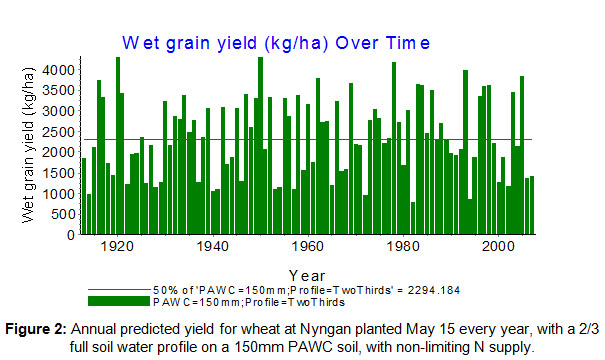
Effect of stored soil water
For a soil of a set water-holding capacity (e.g. 150mm) refilling to different quantities affects the potential yields. The range of subsequent yields is a result of the in-crop rainfall. Thus, more stored soil water results in a higher yield potential for an equivalent amount of rain but in any particular year, high in-crop rain may over-ride a ‘poor’ start (low starting soil water) and vice versa (Figure 3).
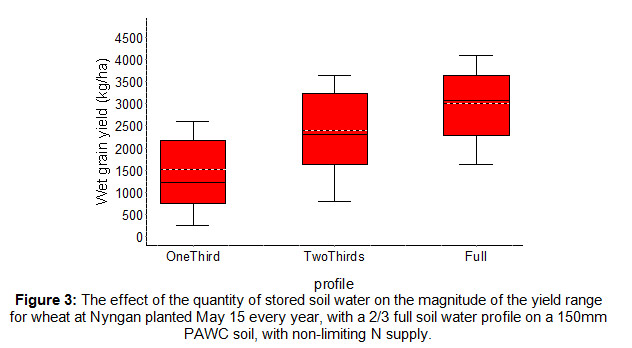
Effect of soil water storage capacity (‘bucket size)
1. When refilled to capacity
A ‘deeper’ soil (higher water-holding capacity) when refilled to capacity, will have a greater yield potential mainly because of the greater quantity of water available at planting (Figure 4). However, separate to this, a deeper soil can have an additional benefit in the ability to accumulate more water as rainfall occurs during crop growth (Figure 5).
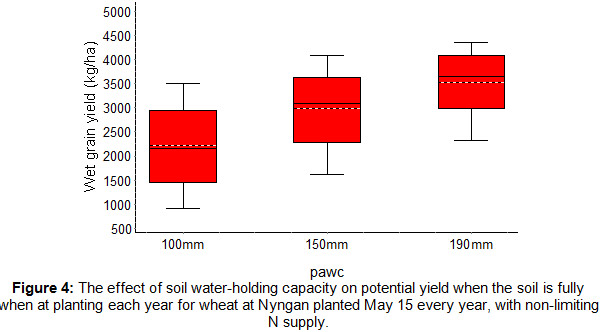
2. When refilled to equivalent soil water contents
A deeper soil has a slightly greater yield potential in some years when rainfall can be accumulated that would otherwise runoff a shallower soil (Figure 5).
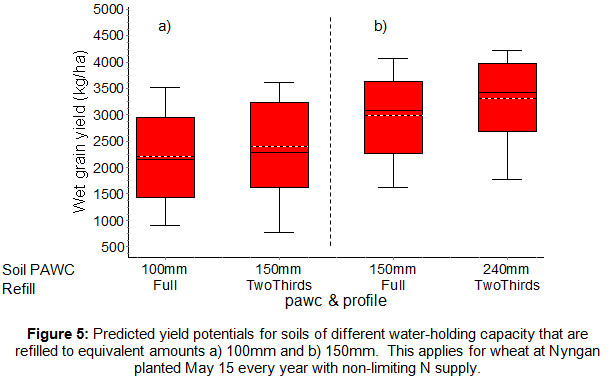
Obtaining Whopper Cropper
The simulations are pre-run for districts around Australia. NSW districts include: Tamworth, Moree, Walgett, Narrabri, Dubbo, Nyngan, Gulargambone, Gunnedah, Coonabarabran, Quirindi, Condobolin, Wagga Wagga, Forbes, Temora, Parkes, Cowra, West Wyalong, Griffith, and Cootamundra.
The program is available through: Back Paddock Company www.backpaddock.com.au
Phone: 1800 557 166. Assistance is also available from the author.
Contact details
Howard Cox
Department of Employment, Economic Development, and Innovation
Ph: 07 46881381
Mb: 0418 708278
Email: howard.cox@deedi.qld.gov.au
GRDC Project Code: South Queensland Far,
Was this page helpful?
YOUR FEEDBACK
